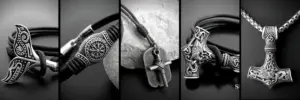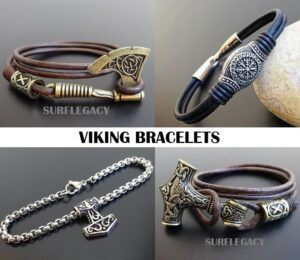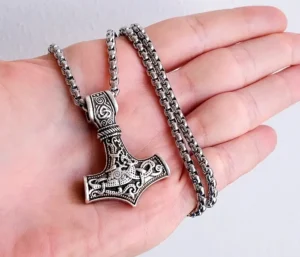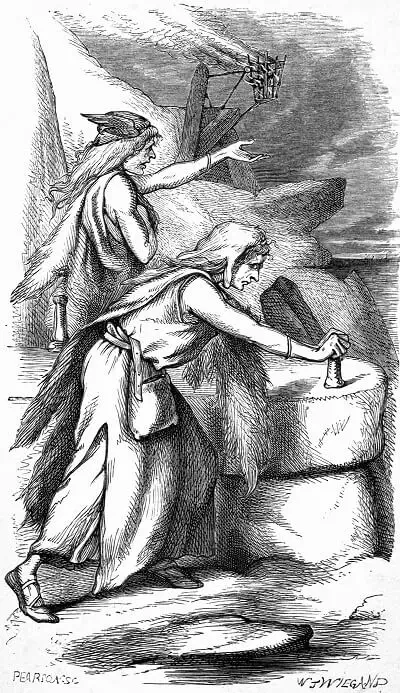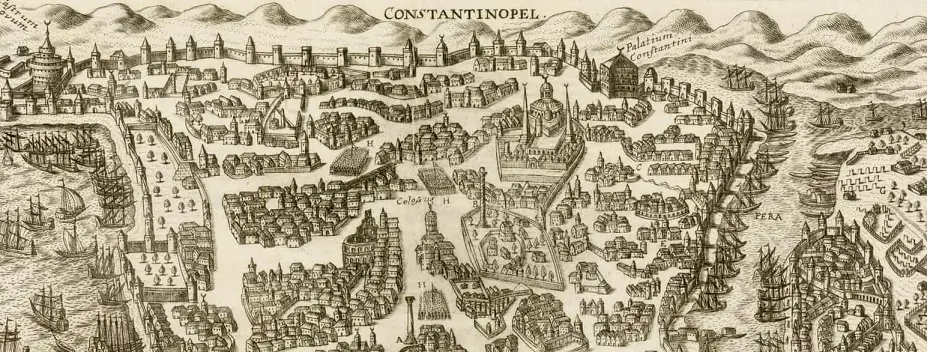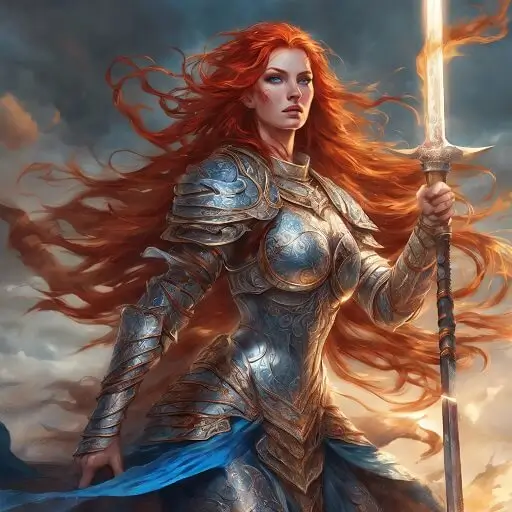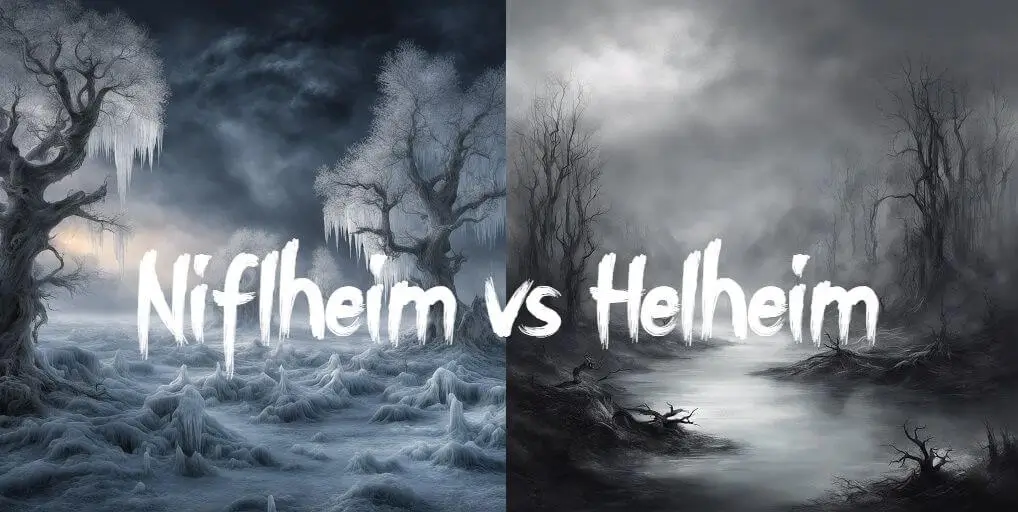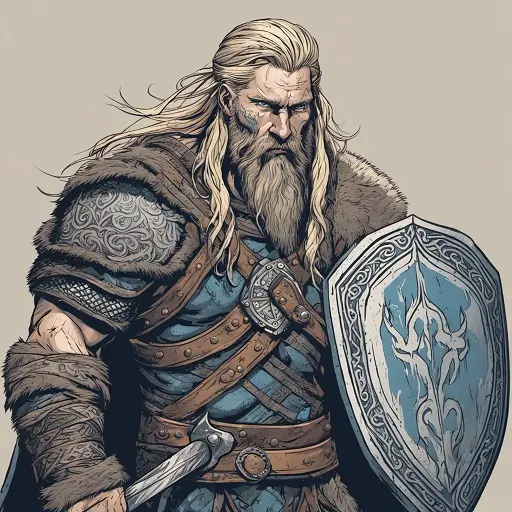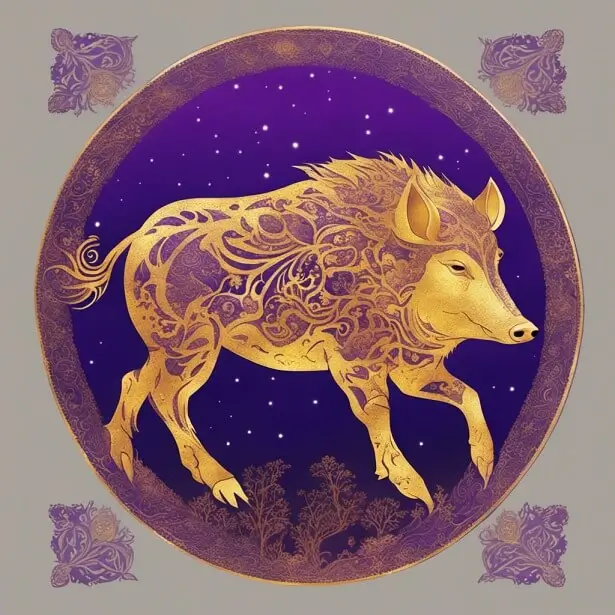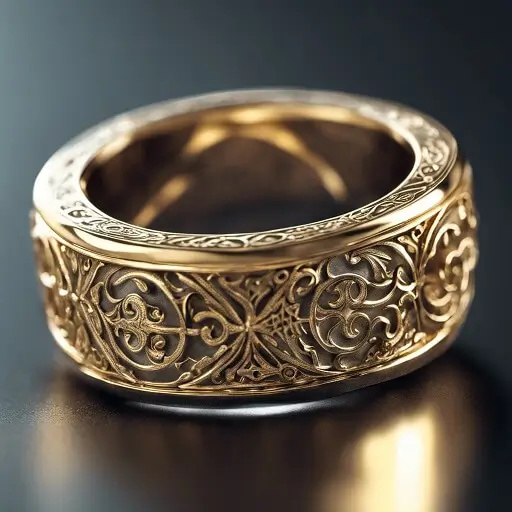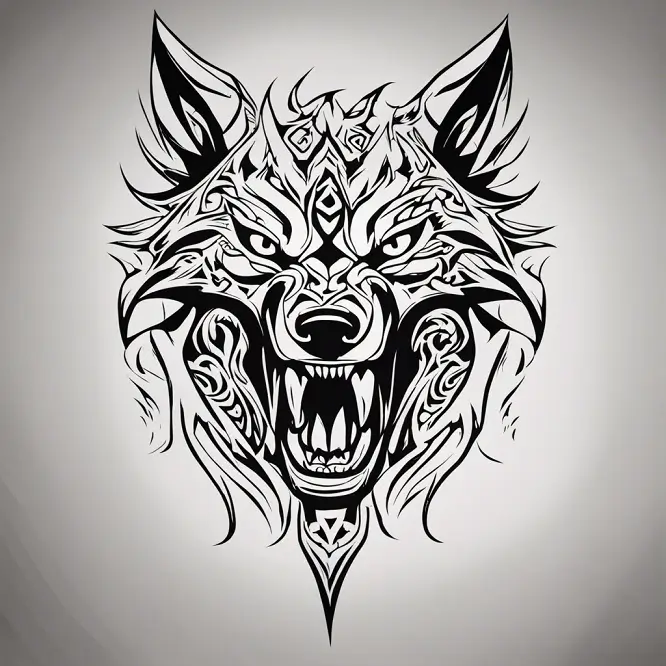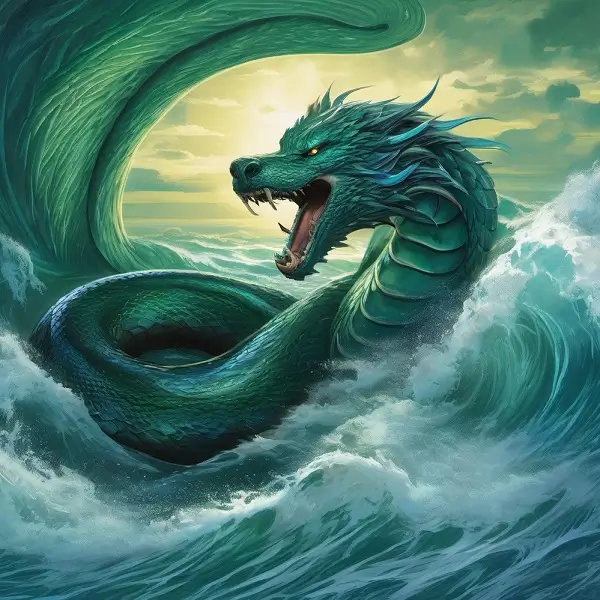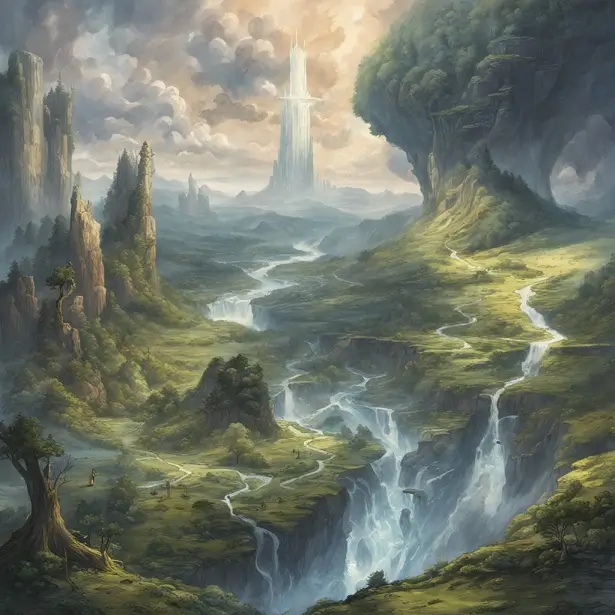The legendary Viking explorer Hrafna-Flóki Vilgerðarson, known as Flocki, pioneered the discovery and settlement of Iceland during the Age of Viking expansion.
His fascinating tales of daring voyages across the treacherous North Atlantic guided by faith in myths, gods, and ravens offer insight into the remote Nordic island nation with its volcanoes, hot springs, and glaciers. Iceland today retains an alluring glimpse into its Viking heritage through language, literature, cuisine, and stunning landscapes.
But just how did early Norse explorers like Flocki first stumble upon this frigid island isolated in the far northern Atlantic? As colorful legends tell, Flocki took tremendous risks venturing across the seas to Iceland. His lasting legacy as one of the most revered Viking explorers reveals much about Iceland’s captivating history intertwined with Norse mythology and lore since its settlement.
Key Facts About Floki:
- Hrafna-Flóki Vilgerðarson was a Norwegian Viking explorer who pioneered the first intentional voyage to Iceland around 860-870 AD.
- He was inspired to find a land far northwest of Norway after hearing tales of its potential for settlement.
- He used three ravens to help guide him to Iceland, earning him the nickname Hrafna-Flóki (“Raven-Floki”).
- Although not the first Norseman to sight Iceland, he was the first to intentionally seek out and land on Iceland with sights set on exploration.
- Hrafna-Flóki spent his first winter in Iceland at Vatnsfjörður on the west coast. Seeing all the drift ice, he dubbed the land “Ísland” (“Iceland”).
- Despite a challenging first winter, he helped pave the way for Ingólfr Arnarson’s Norse settlement of Iceland around 874 AD.
- His daring expedition was a major milestone in the Age of Viking expansion and shaped Iceland’s unique heritage.
- Today Hrafna-Flóki is revered as a legendary figure in Norse lore and popular culture.
- He continues inspiring literature, songs, television, and Icelanders who find pride in their Viking foundations.
- While debated by historians, Hrafna-Flóki nonetheless encapsulates the extraordinary maritime achievements, worldviews, and values that came to define medieval Nordic societies.
Early Viking Exploration and the Mythical Land of Thule
The Viking Age, spanning from around 793 AD to 1066 AD, was a period of ambitious exploration and expansion by Norse communities across Europe.
Renowned as skilled sailors and shipbuilders, Vikings used advanced longships and navigational abilities to explore far reaches of the Atlantic, establishing trade routes and settlements across the ocean. Some voyages were driven by the promise of new lands to cultivate as Scandinavian populations grew.
Others embarked on daring voyages west to seek glory, wealth, and to make a name for themselves. The British Isles were among the first territories beyond Scandinavia that Vikings encountered. Settlements across Scotland, England, and Ireland soon came under Norse control as Vikings returned frequently across the North Sea.
To the north, the Orkney, Shetland, and Faroe Islands also became Norse settlements, offering convenient bases for voyages even further into the Atlantic Ocean. Their seamanship and celestial navigation abilities allowed Vikings to cross large expanses of open sea at lengths thought unimaginable during the Early Middle Ages.
In classical Roman and Greek texts, rumors existed of a land called Thule, believed to lie somewhere northwest of Britain across the Sea. Norwegian Vikings driven by curiosity and wanderlust became determined to find this semi-mythical place.
The first to stumble upon Iceland, located about 670km west of Norway, did so completely by accident around 825 AD. Nevertheless, these chance encounters reinforced rumors of lands to the northwest and ignited a purposeful expedition to find this distant oceanic isle.
The First Sightings of Iceland by Naddod and Gardar
The very first Norseman believed to catch sight of Iceland was a Viking sailor named Naddod (or Naddador). He departed Norway intending to reach the Faroe Islands further west, but severe winds swept him wildly off course.
Naddod ended up sailing about 670km further west than his target, eventually reaching the eastern shores of Iceland. Finding the land completely uninhabited, he dubbed it “Snæland” (Snow Land) due to its frigid appearance and blanket of snow. When the seas calmed, he set sail east and successfully reached his original destination in the Faroes.
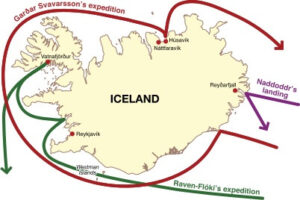
Map indicating the travels of the first Scandinavians in Iceland
Around 860 AD, another Norseman named Garðar Svavarsson unintentionally came upon Iceland’s northern coast after his voyage from mainland Scotland was thrown off track by a powerful storm.
This proved Iceland was not connected to Greenland as some believed, but rather was an island. Garðar spent the winter in Iceland at modern-day Húsavík, building a small settlement.
He spoke favorably of the land upon returning to Scandinavia, naming it Garðarshólmi (Garðar’s Isle). While these explorers found Iceland by chance, Hrafna-Flóki would soon launch an intentional expedition to find this mysterious land farther west of Norway.
Hrafna-Flóki Sets Sail to Find Iceland
Inspired by the rumors from Garðar and Naddod, a chieftain from western Norway named Hrafna-Flóki Vilgerðarson became determined to sail west and settle this new land himself.
He assembled a crew and set out from Norway around 868 AD, as described in the medieval Icelandic sagas Landnámabók and Flóamanna saga. These sagas, passed down orally before being recorded, highlight Floki’s daring journey into the unknown Atlantic in search of an island he only knew from myths and hearsay.
They portray these intrepid explorers relying on their self-reliance, the wisdom of the gods, and signs of nature to guide them across the vast open ocean.
According to legend, Hrafna-Flóki stopped first at the Shetland Islands northeast of Scotland, where tragedy struck when his daughter drowned.
He pressed onwards to the Faroe Islands where his crew restocked food and supplies. At this midpoint rest area in the distant Atlantic, Hrafna-Flóki gained three ravens to assist him with navigation across the remaining ocean.
Releasing birds and following their flight was a traditional Viking technique for identifying the direction of land while out of sight far from shore.
With his ravens and crew aboard his sturdy Viking longship, Hrafna-Flóki set sail from the Faroes directly into the swells of the open Atlantic Ocean. Using his expertise in reading the sun, stars, wind, and bird flight patterns to stay on course, the bold Norse captain persevered west.
When the coastline of Iceland came into view beneath the misty northern sky, Floki generations later would be praised for captaining one of the early purposeful Norse expeditions directly from Scandinavia to Iceland.
Hrafna-Flóki’s Arrival and First Winter in Iceland
Hrafna-Flóki first dropped anchor at Vatnsfjörður on Iceland’s west coast after following the flight path of his third raven northwest across the ocean.
This historic landing around 868 AD marked the first winter a Norse crew intentionally spent in Iceland. According to the Book of Settlements (Landnámabók), Floki’s crew numbered over twenty people, including women and children belonging to these settling families.
Without knowledge of Icelandic winters, which proved far crueler than in their native Norway, Hrafna-Flóki’s crew failed to adequately prepare or provision for the tough months ahead. They spent the summer fishing abundantly, but did not harvest enough hay or stockpile sufficient supplies before the extreme cold and snows of winter set in.
Lacking proper shelter and food, all of their cattle perished over that devastating first winter. Come spring, Hrafna-Flóki returned to Norway discouraged, declaring Iceland a frigid wasteland unfit for settlement.
However, others heard of this newly discovered land and rumors continued swirling. Just a few years later, Ingólfr Arnarson would successfully lead Iceland’s Norse settlement starting around 874 AD.
Legends of Naming Iceland – Hrafna-Flóki’s Legacy
According to legend, it was Hrafna-Flóki who bestowed the icy land its name after gazing upon a fjord filled with drift ice during his difficult first winter there.
Watching the frozen sea ice piling up, he deemed it a fitting name to call this frigid isle Ísland – Iceland. Some also believe he named isolated peninsulas like Snæfellsnes based on their snowcapped appearance. This plays into his legacy as both discoverer and namer of Iceland’s dramatic landscape.
While not the first Norse explorer to sight Iceland, Hrafna-Flóki holds a revered place in Icelandic history for captaining the first purposeful expedition from Scandinavia with the intention of settling there. He paved the way for expeditions that followed, including the successful colonization attempted by Ingólfr Arnarson.
Without Hrafna-Flóki’s daring journey into the unknown guided by his faith in the gods and ravens, the settlement of Iceland and incorporation into greater Norse civilization may have unfolded much differently.
Evidence Iceland was Discovered Earlier than Floki
Despite legends crediting him as Iceland’s pioneering discoverer, evidence suggests Norse and Irish seafarers landed in Iceland before Floki’s celebrated voyage sometime between 868-870 AD.
Medieval Icelandic manuscripts reference an Irish people known as Papar who lived in Iceland before the arrival of Norse settlers. Sources also indicate Norse sailors hunting walruses came upon Iceland well before its permanent colonization.
Archaeological evidence also challenges the notion that Iceland was undiscovered wilderness until Hrafna-Flóki’s time. Ruins of a Norse longhouse dated to around 800 AD were unearthed at Þjóðveldisbærinn Stöng in southern Iceland.
Other early artifacts like the Þjórsárdalur amulet uncovered in eastern Iceland also suggest periodic contact, trade, or settlements predating Hrafna-Flóki by several decades.
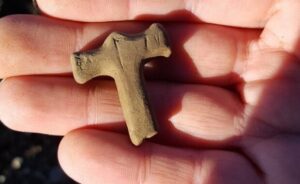
The Þjórsárdalur amulet was carved out of sandstone. Photo – Fornleifastofnun Íslands
While he was likely not the original Norse discoverer, Hrafna-Flóki remains essential for embarking on the first organized exploratory expedition that paved the way for full-scale Norse settlement. His legendary voyage still represents a pivotal chapter in Iceland’s unique Viking heritage.
Even if elements are more myth than fact, the tales capture the spirit of exploration, self-reliance, and courage that drove these Norse seafarers into dangerous Atlantic waters on a quest to find new lands.
Unraveling Truth From Myth in The Sagas
Much of Hrafna-Flóki’s story is pieced together from early Icelandic literature like the Book of Settlements (Landnámabók) and Saga of the Icelanders (Íslendingabók) that were written down centuries after the Viking Age despite being based on earlier oral storytelling traditions.
As a result, the fine line between historical truth and fiction is often blurred with legendary sagas. Many modern historians approach these centuries-old tales with skepticism, questioning whether Hrafna-Flóki was a real explorer or an emblematic figure of Viking discovery invented through storytelling myth.
However, significant aspects of his voyage align with broader records of Viking expansion, ship capabilities, and navigation methods from this pioneering era. Kernels of truth regarding Iceland’s discovery and settlement very likely formed the basis of his legend over the centuries.
While allowances must be made for exaggeration or embellishment, the legends provide meaningful perspective into Viking society, cultural traditions, and values.
The Age of Viking Exploration and Settlement
The Viking Age spanned centuries of ambitious voyages, warfare, trade, and colonization that reshaped medieval power structures in Europe and beyond.
As their Northern European populations expanded, Vikings set sail across vast distances in pursuit of resources, riches, and glory using advanced sailing and navigational abilities. They traversed seas and rivers to reach territories as far as Newfoundland, Constantinople, and the Caspian Sea while also conquering swaths of mainland Europe.
Much of their expansion unfolded across the North Atlantic, with Iceland arising as a strategic North Atlantic island stopover between Scandinavian homelands, the British Isles, and Greenland.
While stories of Hrafna-Flóki may contain mythologized elements, his voyage encapsulates the Viking spirit of exploration by highlighting the lengths bold captains would go guided only by faith in the gods and their belief in rumors of lands on the distant horizon.
First Settlers of Iceland – Ingólfr Arnarson and Norse Colonization
Despite a rocky first winter, Hrafna-Flóki’s journey inspired other Vikings to follow in his wake. Around 874 AD, the Norse chieftain Ingólfr Arnarson became the first permanent settler of Iceland.
He took land in southwestern Iceland, claiming Reykjavík’s coastline as the site for his farm and homestead. Unlike Hrafna-Flóki, Ingólfr prepared for harsh winters and successfully built up Reykjavík as a long-term Norse settlement.
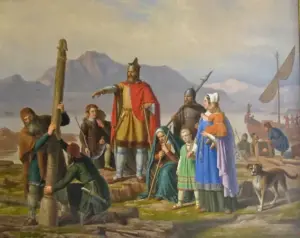
Ingólfr Arnarson, the first settler of Iceland, newly arrived in Reykjavík – Johan Peter Raadsig (1850)
Confusion exists around Ingólfr’s background before arriving in Iceland. Different sources suggest he came from Norway, Sweden, or was born to a Norse family already settled in the British Isles.
Likely landing between 870-874 AD according to the Book of Icelanders (Íslendingabók) he named Reykjavík (Smoky Bay) after the coastal steam vents. Within the next 60 years, Norse explorers and settlers tamed Iceland’s rugged terrain, established farms across much of the island, and developed a unique Norse-derived culture touched by Gaelic influences.
The age of settlement marks Iceland’s firm incorporation into the Viking world. Sources cite anywhere between 8,000 to 20,000 settlers migrating from Scandinavia and Viking territories in northern Britain.
The Icelandic era of settlement lasted until approximately 930 AD when the island became fully cultivated by Norse communities tracing lineage to Norway and Nordic parts of the British Isles.
Norse Society and Governance in Iceland
As the Age of Settlement wound down around the 10th century AD, Norse communities had successfully tamed Iceland’s rugged natural features and established sophisticated governance. Power was decentralized across chieftains governing local districts.
The rugged terrain and vast distances between settlements enabled this loose confederation bound by common culture, language, and Norse laws. Iceland also adopted the Old Norse religion worshipping gods like Odin and Thor.
Thingvellir, an expansive lava plain on Iceland’s southwest coast, emerged as the assembly point where chieftains gathered to settle disputes and make decisions through laws passed at the Alþingi (general assembly). Although lacking a king, this system united Iceland under shared Norse traditions.
Icelandic society was profoundly shaped by its Nordic settler population and the literature they brought with them recounting Norse legends and histories.
Poetry, stories, and myths were passed down orally until scribes began preserving them in manuscripts like the Poetic Edda, Prose Edda, and sagas recounting the deeds of Norse gods, heroes and historical figures.
This rich literary tradition connecting Icelanders to their Scandinavia ancestry and pagan past remains vibrant today. Iceland’s extensive Norse lore and tales still inspires many.
The Remarkable Legacy of Floki – His Enduring Influence in Popular Culture
Hrafna-Flóki may have sailed and explored Iceland sometime around 868 AD, but his daring voyage lives on today through literature, pop culture, and historical intrigue surrounding the Norse discovery of Iceland.
Elements of his story – navigating with ravens, the near-mythical nature of his voyage, naming Iceland – turned him into a legendary figure of Viking exploration.
As old Nordic stories were recorded and romanticized, Hrafna-Flóki emerged as a central figure tied to Iceland’s origin story. Hismystique only grew with time, cementing his place alongside other icons like Leif Erikson as the epitome of Viking wanderlust, courage, and indomitable spirit.
A Cultural Touchstone Revived in Modern Pop Culture
After centuries existing as a background character in medieval Icelandic literature, Hrafna-Flóki stepped back into the limelight through modern pop culture.
The History Channel’s dramatic TV series Vikings, which premiered in 2013, chronicles the adventures of Ragnar Lothbrok and his fellow Norse raiders across Europe and beyond. Among them is the warrior Floki, a boat builder and eccentric devotee of the gods based loosely on the legendary voyager Hrafna-Flóki.

Played masterfully by actor Gustaf Skarsgård, Floki’s antics, mannerisms, and adventures summon the Viking spirit embodied by his real-world namesake centuries earlier. This vivid embodiment of Hrafna-Flóki’s daring voyage to Iceland and mystical persona reinvigorated interest in his story and legacy for the 21st century.
The Allure of Hrafna-Flóki for Historians and Explorers
From historians researching Iceland’s origins to modern seafarers, many continue looking to the past for lessons from Hrafna-Flóki’s remarkable voyage.
Historians debate elements of the account, weighing embellishments versus truth. But his legendary journey nonetheless reveals much about Viking society, expansionist drives, and the perils of exploring the North Atlantic long before modern navigation.
For those still captivated by old Norse epics today, Hrafna-Flóki represents the pinnacle of adventure across the seas guided only by wit, intuition, lore of the gods, and signs from ravens.
Modern sailors retracing early Viking routes are also inspired by tales of Hrafna-Flóki’s oceanic daring while appreciating how far nautical navigation has advanced since his era. And in Iceland, Hrafna-Flóki remains an iconic Father of the Nation figure whose leap into the unknown changed the island’s destiny.
The Intersection of History and Myth
Like fellow pioneering Norse explorers Erik the Red or Leif Erikson, details of Hrafna-Flóki’s biography blend with fiction over the centuries. But historians look beyond determining what is pure myth by understanding why Vikings cherished these legends, and what cultural meaning they held for Nordic societies.
Whether or not Hrafna-Flóki himself gave Iceland its icy moniker, the tale reveals medieval Icelanders’ need to explain their island’s name and tie it to their Viking foundations.
The story captures the worldview of early Icelanders by using shared Nordic symbols they valued – ravens representing Odin, reading nature’s omens, the role of fate and faith steering oceanic journeys.
Much like classical Greek or Roman mythology, old Norse legends reveal the cultural values, worldviews, and histories of those who first told them. As enduring folklore, they offer a window into what drove these daring explorers and defined their society that historians still prize today.
Iceland’s Viking Foundations Woven into the Island’s Cultural Identity
Today, Iceland remains profoundly connected to its Viking heritage traced back to the Age of Settlement initiated by Ingólfr Arnarson. That period laid cultural foundations tied to Old Norse language and literature that still define Icelandic identity.
Isolated in the harsh northern Atlantic since its first settlers arrived, Iceland retains the most intact version of Old Norse dialects once spoken across Scandinavia. J.R.R. Tolkien looked to Icelandic as inspiration for the Elvish languages in Lord of Rings, finding poetic Old Norse tones still vibrant and close to their Viking Age origins.
Iceland’s long literary tradition originating from medieval manuscripts documenting Norse mythology and Viking deeds represents their strong ties to Scandinavian roots. Classic Icelandic sagas detailing Norse gods, heroes, and history are considered masterpieces of medieval literature treasured as part of Iceland’s cultural heritage today.
From ancient texts like the Poetic Edda and Prose Edda to the distinctive Icelandic horse brought by the island’s first settlers, the Viking influence remains engrained.
And the story of Hrafna-Flóki, though partly mythologized, represents Iceland’s origin story as a remote Nordic island first stumbled upon through bold Viking seafaring. Hrafna-Flóki pioneered crossing the seas guided by ravens to scout new lands for Norse settlement.
Although details are hazy, his legacy as Iceland’s famous first explorer echoes through later literature and history. Tales of his voyage connect Icelanders today to that intrepid Viking mariner who dared to venture beyond Norway’s horizon guided only by his shipbuilding skills, navigational wit, and faith in his ravens. In Hrafna-Flóki, the adventurous heart of Viking wanderlust lives on.
Hrafna-Flóki in the Popular Imagination Today
Claiming history’s most daring explorers as national heroes is a tradition most countries partake in. Extraordinary figures like Christopher Columbus, Captain Cook, or Neil Armstrong come to represent pioneering spirit and ignite imaginations.
In Nordic countries, including Iceland, that figure embodying ambition, risk-taking, and trailblazing is Hrafna-Flóki. He signifies Iceland’s origin story – a remote, mysterious island first stumbled upon through bold Viking seafaring into the vast unknowns of the northern Atlantic Ocean.
Hrafna-Flóki dared to embark toward distant horizons guided only by faith, intuition, and ravens symbolizing the god Odin. To those aboard, no oceans seemed too vast that their sturdy longships could not carry them to distant shores.
The mystique surrounding Hrafna-Flóki captures this unrelenting Viking quest for new lands and glory. And in Iceland specifically, Hrafna-Flóki represents the earliest Norse explorer who set foot upon its coast – sparking this island’s incorporation into the Viking Age.
Today the legendary voyager inspires literature, art, songs, and festivities honoring Iceland’s national heritage. Hrafna-Flóki’s famous voyage lives on as a fundamental story in how the remote island’s destiny became tied forever to its Viking discoverers.
Details Surrounding Hrafna-Flóki – The Known and the Mystery
Much about Hrafna-Flóki remains unknown centuries after his famed voyage. The sagas provide imaginative, although not necessarily strictly factual, accounts of his journey.
However, aspects of his quest – its motives, known navigation and shipbuilding abilities, wider context of Viking expansion – can be corroborated from broader records of this era. Provided allowances for embellishment in oral storytelling over generations, a probable narrative emerges:
- Hrafna-Flóki was a real Norse Viking explorer determined to find new lands rumored northwest of Scandinavia – the semi-mythical Thule.
- He embarked sometime in the 9th century AD from western Norway, a hub for Atlantic voyages.
- Advanced longships and mastery of celestial navigation allowed voyages well across the open seas.
- Stopovers in Shetland and the Faroes provided resupply stations before the longest leg sailing directly west.
- Release of supply ravens was indeed a technique used by Viking navigators to identify the direction of land while offshore.
- After sailing roughly 600 nautical miles west from the Faroes guided by ravens, Hrafna-Flóki did reach Iceland’s coast.
- He landed in northwest Iceland sometime between 860-870 AD, building temporary settlements.
- Difficult first winter conditions may have seen him lose livestock and prompt a return to Norway.
- Though frustrated initially, his voyage was rediscovered years later and opened the door to permanent Norse settlement.
Beyond these general contours, details of dates, crew members, family members, and timeline grow increasingly murky. Much regarding Hrafna-Flóki’s background and biography will remain open-ended. But the legendary voyager nonetheless achieved the improbable during his era – venturing into open ocean guided only by wit and faith to reach a land rumored of in lore, then returning to tell the tale.
Why Experts Debate Aspects of Hrafna-Flóki’s Voyage
Historians debate details surrounding Hrafna-Flóki for good reason. Medieval Icelandic literature transmits his story, but was only recorded centuries later. Time allows fiction to blur with facts. Tales evolve to suit storytelling and cultural mythmaking. The sagas portraying his voyage reflect this.
No definitive facts document Hrafna-Flóki himself or his journey. Only wider context from archaeology, documentation of Viking navigation methods, and Norse expansion in the region corroborate aspects of his tale. Without primary written sources from his lifetime, historians hesitate to take sagas as pure fact.
This leaves the door open to debate the mythology that may have built up around Hrafna-Flóki over centuries of oral storytelling in Iceland before manuscripts were written. Historians must discern between kernels of truth versus mythologizing.
Determining what is real versus fable will continue challenging researchers who prize accuracy when piecing together histories. But the tradition of questioning verifiable facts versus exaggeration helps scholars separate valuable history from cultural mythmaking.
For Hrafna-Flóki, truth likely lies somewhere in a gray area between the two extremes.
Becoming Iceland’s Famous First Explorer Over Time
Medieval Icelandic literature does not portray Hrafna-Flóki as uniquely important compared to other settlers and explorers who ventured to Iceland around his timeframe in the late 9th century AD. But over subsequent generations, his story became more legendary and distinctive in the imagination of Icelanders constructing origin stories.
By the time sagas were written down centuries later, Hrafna-Flóki emerged as the famous first explorer of Iceland – more revered than other early documentarians like Naddod or Gardar. This reflects a natural human tendency to distill history into singular pioneers and origin stories.
Hrafna-Flóki’s voyage contained just the right blend of extraordinary achievement, hardship, and mysticism to make his story compelling and uniquely Icelandic.
As medieval Icelanders identified culturally with Viking heritage, a legendary figure like Hrafna-Flóki fulfilled their need for a founding explorer who heroically embodied Norse seafaring strengths that allowed their island’s discovery.
The Interplay Between History and Cultural Mythology
Cultural mythology shapes collective identity by preserving tales that reinforce histories, values, and worldviews. Myths often contain truth at their core even if details become embellished over generations of storytelling.
For Icelanders, origin narratives like Hrafna-Flóki’s voyage foster connections between medieval Iceland and the Viking Age. They reinforce Norse cultural heritage through legendary figures displaying traits Icelanders still identified with centuries later. Myths allow meaningful themes to become more powerful and resonant than dry facts alone could achieve.
Hrafna-Flóki as the first Icelander conveyed ideas early Icelanders valued – bold maritime exploration, reading nature’s signs, belief in fate and the gods steering fate. The symbolic ravens represent how pagan Norse religion and folklore colored the medieval mindset.
Even if Hrafna-Flóki’s biography is partly invented, it still reveals much about Icelandic perspectives on their Viking forebears who shaped history and identity. The voyage’s fiction speaks its own truth.
The Lasting Spirit of Floki Across Icelandic Culture
In Hrafna-Flóki, Iceland found an ideal legendary figure to represent Viking courage, skill, and trailblazing spirit – qualities still admired today.
The mariner who guided his longship due west into the unknown guided only by wisdom, lore, and ravens embodied values medieval Icelanders wanted associated with their revered Viking founders.
Hrafna-Flóki gave human form to the daring Norse seafarers who discovered Iceland thanks to abilities modern society still celebrates – boldness, faith against odds, navigational genius, and intrepid belief in myths and omens. For Icelanders seeking connection between contemporary culture and Viking roots, Hrafna-Flóki remains an accessible icon inherited from the Age of Settlement.
Through literature, song, and celebrations, his legacy continues inspiring Icelanders today to take pride in bold explorers who played a pivotal role in their island’s history and identity. Centuries later, the courageous spirit of discovery ascribed to Hrafna-Flóki still sails on.
In Summary: Highlights of Hrafna-Flóki’s Lasting Significance
- Braved the treacherous North Atlantic guided only by faith in lore, gods, and ravens – embodies bold Viking spirit still admired today
- Personifies Iceland’s origin story as a remote Nordic island first discovered through pioneering Viking seafaring
- Sailing west into the unknown with only wisdom and skill captures the extraordinary maritime capabilities of Norse explorers
- Highlights innovation in vessel design, navigation, and self-sufficiency that allowed Vikings to expand across oceans
- Traces Iceland’s intimate ties to Viking heritage through values like courage, quest for glory, belief in fate and omens
- Symbolizes Iceland’s remote geography at the mercy of the North Atlantic seas since first settlement
- Illustrates the medieval Icelandic worldview shaped by Old Norse religion, folklore, language, and legends
- Inspires literature and arts celebrating Iceland’s national heritage and identity rooted in medieval Viking society
- Embodies the enduring mystique, allure, and bravery surrounding the Age of Viking discovery and expansion
So while details of his voyage may remain partly shrouded in the mists of time, Hrafna-Flóki nonetheless stands tall as a cultural giant in the mindset of Icelanders.
His valiant tale of exploration driving westward into the unknowns of the ocean came to represent the extraordinary spirit of discovery, skill, and courage that allowed a remote Nordic island to become incorporated into the remarkable Viking expansion across the North Atlantic.
By daring to venture beyond the expected, legends hold that Hrafna-Flóki charted a course straight into Icelandic history forever.
FAQ
Who was Hrafna-Flóki?
Hrafna-Flóki Vilgerðarson was a legendary Norwegian Viking explorer believed to have led one of the first purposeful expeditions from Scandinavia to Iceland in the late 9th century AD. He used ravens to help guide his voyage, earning him the nickname “Hrafna-Flóki” or “Raven-Flóki”.
When did Hrafna-Flóki reach Iceland?
The sagas depict Hrafna-Flóki reaching Iceland sometime around 860-870 AD. However, scholars debate the exact date which remains uncertain.
Was Hrafna-Flóki the first to discover Iceland?
No, other Norse explorers like Naddod and Gardar are recorded reaching Iceland before Hrafna-Flóki, although only by accident. Hrafna-Flóki is credited with leading the first purposeful voyage to Iceland with the intention of exploring the land.
What challenges did Hrafna-Flóki face?
According to legend, Hrafna-Flóki faced a difficult first winter in Iceland that killed his livestock, leading him to temporarily abandon plans for settlement. His voyage also faced challenges like storms, harsh weather, and navigating across the remote North Atlantic.
How did Hrafna-Flóki navigate to Iceland?
Accounts suggest Hrafna-Flóki used ravens and his knowledge of reading the sun, stars, and nature patterns to navigate westwards across the open ocean before sighting Iceland’s coast.
Why is Hrafna-Flóki a revered figure in Iceland?
As one of the first Norse explorers to purposefully sail to Iceland and pave the way for settlement, Hrafna-Flóki holds a legendary status. His daring journey represents Iceland’s Viking discovery and the extraordinary seafaring abilities of these Norse settlers.
What is Hrafna-Flóki’s cultural legacy?
Hrafna-Flóki remains an iconic figurehead in Icelandic history and culture. His tale of exploration and perseverance encapsulates values like courage, quest for glory, innovation, and belief in omens that defined Viking society in Iceland during the Age of Settlement.
How accurate are the sagas about Hrafna-Flóki?
Historians debate the accuracy of medieval Icelandic sagas chronicling Hrafna-Flóki’s journey, which were recorded centuries later. However, they likely contain some truth regarding his voyage and its role in Norse exploration of Iceland.
Why does Hrafna-Flóki remain influential today?
As a bold adventurer who personifies Iceland’s Viking discovery and settlement, Hrafna-Flóki continues capturing imaginations through books, TV, and celebrations of Iceland’s national heritage. His daring spirit still inspires and intrigues audiences today.
Conclusion
Floki was not only a legendary Viking explorer but also a symbol of innovation and curiosity. His daring expeditions, fearlessness, and pioneering spirit set him apart from his contemporaries, leaving a lasting legacy that continues to captivate our imagination today. Floki’s story serves as a reminder to embrace curiosity, take risks, and carve our own path in life.
Key takeaways from the life of Floki
Floki’s life offers valuable lessons that can be applied to our own journeys:
- Embrace curiosity: Floki’s insatiable curiosity drove him to explore uncharted territories and expand his horizons. Curiosity is a powerful force that can lead us to new discoveries and opportunities.
- Take risks: Floki was not afraid to take risks and venture into the unknown. Sometimes, it is the risks we take that lead to the greatest rewards.
- Be resilient: Floki faced numerous challenges and setbacks during his expeditions, but he remained resilient and persevered. Resilience is crucial in overcoming obstacles and achieving success.
- Leave a lasting legacy: Floki’s accomplishments have left an indelible mark on Viking history. Leaving a lasting legacy requires striving for greatness and making a meaningful impact.
In conclusion, Floki’s story is a testament to the adventurous spirit and resilience of the Vikings. His legacy serves as a reminder to embrace curiosity, take risks, and leave a lasting impact on the world around us.
Shop Viking Jewelry
Are passionate about Vikings or Norse Mythology?
Finding the ideal piece of Viking Jewelry can be challenging and time-consuming, especially if you lack inspiration or don’t know where to look.
Surflegacy, has you covered. We have a wide range of Handmade Jewelry in various styles, shapes, colors, and materials, to accentuate your Viking spirit and look. Do not hesitate to visit our selection HERE
Whatever you wear, you’ll find the ideal trendy piece to complement your wardrobe. Our jewelry is designed to be worn every day, no matter where you go or what season is. Are you ready to step up your wardrobe game?



